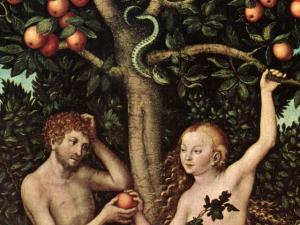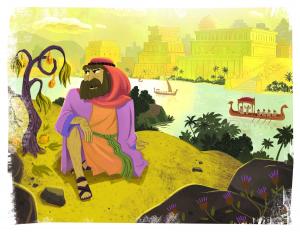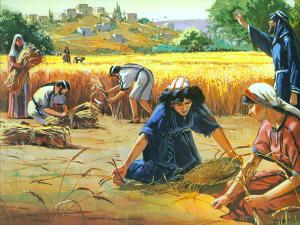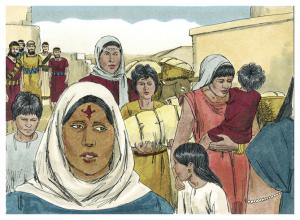
The last post was a trip away from Bible stories for another story by René Girard. Girard’s theory purports to explain the origin, in rivalry, the scapegoat, and sacred violence of practically everything that distinguished humans from animals. Soon we return to the Bible, specifically the story in Genesis of Adam and Eve’s Original Sin. We’ll see imagined rivalry and the first instance of violence in the Bible. Before that, here’s a story that’s not exactly in the Bible. You can think of it as a story that the devil might have told if he were the story-telling type.
Episode 3 in the series “Opening the Scriptures on the Way to Emmaus: Why Did Jesus Have to Suffer.” Introduction and a Table of Contents here.
Original sin, devil’s version
God had everything anybody could possibly want, but he still wasn’t happy. There was no one to admire his greatness. So he decided to make a world. He would share much of his wealth but not all of it. God planted a garden and put a woman there. He told her she could eat all the food she wanted except the fruit of one tree, placed right in the loveliest spot in the garden so the woman would be sure to see it often and be reminded that he was God and she was not.
Eve—that was the woman’s name—liked pretty things and often wandered in that part of the garden where the forbidden tree grew. She really wanted some of the fruit of that tree, but she was afraid to touch it. God had told her if she did she would die. She didn’t understand why she wanted the fruit so badly, but the snake knew. He told her, “You’re mad at God, and you should be. God knows if you eat from that tree you’ll be like him. You feel it in your gut. God is just using your fear of death to keep you in your place.”
Eve reached up and touched, then picked, and ate the fruit of that tree. She didn’t die; instead her eyes were opened and she understood what God had been doing to her. The snake was right. She left God’s garden and would have nothing to do with God from that day on. Life suddenly got a great deal harder for Eve as God found ways to take revenge, but she didn’t care.
Rivalry
That was a story about rivalry between a deity and a human being. It projects feelings humans often feel (and nearly always deny that they feel them) onto God. It nourishes a lie about a divine rival, a god of petty rules and arbitrary consequences.
The Original Sin story in the Bible also contains the idea that God is a rival for the humans, but it’s the snake, not the narrator, who says it; and the snake is lying. Adam and Eve set themselves up as God’s rivals because they believe the snake and misunderstand God. The Bible’s story exposes the lie.
Two people live in a beautiful garden, a man and a woman. They exist in harmony and equality. They’re naked. Without rankings they don’t need the signals of rank that clothes send. At the end, when the husband outranks the wife, the reader sees clearly that it’s because of sin. God didn’t mean things to be that way. In fact, God, like the woman, like one in the lower place, sews some decent clothes for the couple before sending them out into the wilder world. God sacrifices some of his own animal creatures to do so. (Genesis, Chapter 3)
This is not a god who is anyone’s rival.
Jesus in the story
Imagine Jesus placing himself in this story as he interprets Scripture on the way to Emmaus. I think Jesus would be the innocent animals that gave themselves up to clothe the two wayward but still loved humans. A friend who was pastor at the local Assembly of God Church takes the whole story as literal history. He believes that these animals were the very first living things on earth ever to die, the first blood that was ever shed. God himself commits the first act of violence.
Most of us would find that incredible scientifically, but I like the symbolism. Nature gives herself and keeps on giving even though we continually abuse her. Jesus telling this story would identify with Nature, represented by the animals, who gave their skins to help the humans.
The Church has always found hints of the Gospel in the story of the Original Sin. It is seen in a curse God invokes on the snake. But that curse is really indefinite, especially in modern, more accurate translation:
The descendant of the woman “will strike at your head, while you strike at his heel.” (Genesis 3:15)
For a positive outcome it doesn’t say much. You have to do a lot of reading-in to see Jesus’ victory over Satan there. I see good news in this story where God and the animals provide new clothes for the two sinners. You could call that a sacrifice, but it’s about the opposite of a violent, sacred offering that restores friendship with God. The offering isn’t to God; it’s to the people. And God’s friendship doesn’t have to be restored because God always loved Adam and Eve.
We call Jesus’ death on the cross a sacrifice, but a sacrifice to whom? Can we think of it as an offering to human beings rather than to God?
Image credit: Evidence for God from Science, via Google Images











